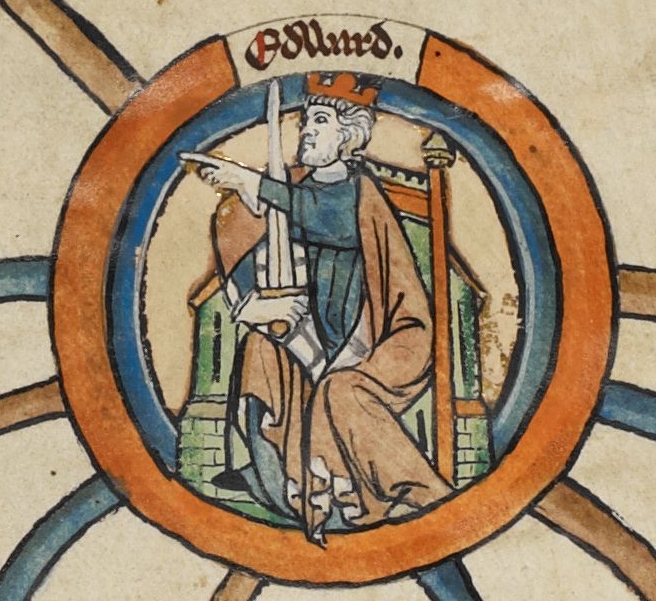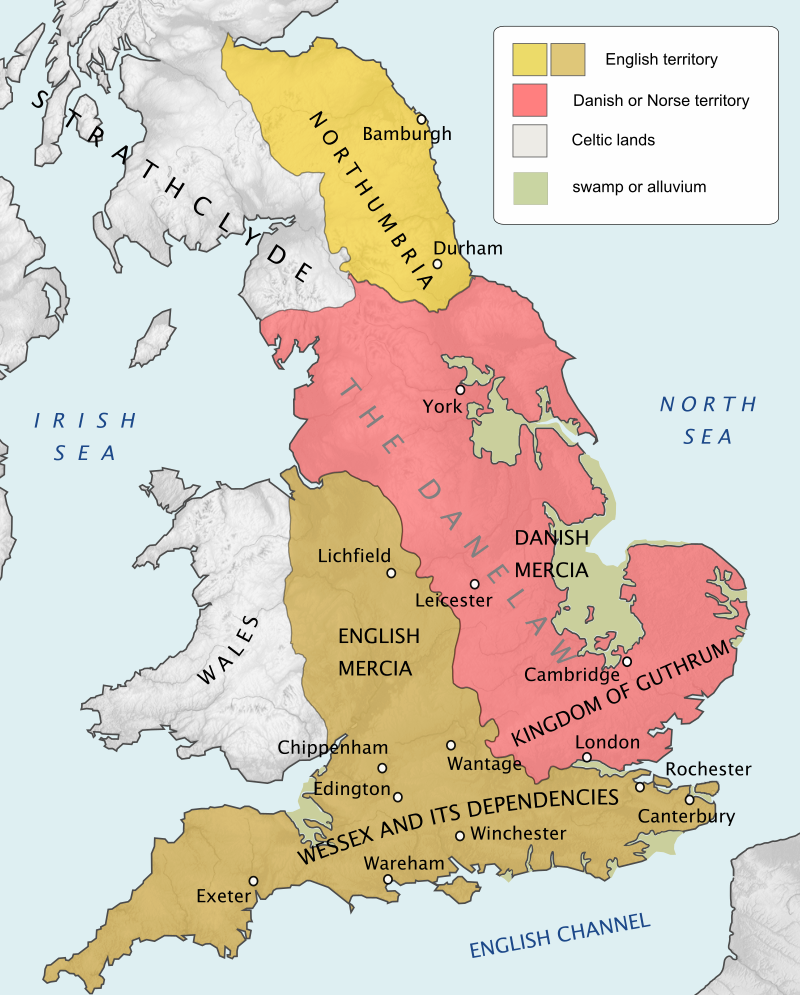by Susan Flantzer © Unofficial Royalty 2019

Credit – Wikipedia
Born circa 874, probably at the royal palace in Wantage, now in Oxfordshire, England, Edward the Elder, King of the Anglo-Saxons was the elder of the two sons and the second of the five known children of Alfred the Great, King of Wessex, King of the Anglo-Saxons and his wife Ealhswith, daughter of a Mercian nobleman Æthelred Mucel, Ealdorman of the Gaini and his wife Eadburh, a member of the Mercian royal family. Edward was not called “the Elder” during his lifetime. At the end of the tenth century, “the Elder” was added to his name to distinguish him from King Edward the Martyr.
Edward had three sisters and one brother:
- Æthelflæd, Lady of the Mercians (died 918), married Æthelred, Lord of the Mercians, had one daughter
- Æthelgifu, Abbess of Shaftesbury
- Æthelweard (died circa 922), married and had two children
- Ælfthryth, Countess of Flanders (died 929), married Baldwin II, Count of Flanders, had four children
According to Asser, the Welsh monk who was Alfred the Great’s contemporary biographer, Edward was brought up with his youngest sister Ælfthryth. They were educated at court by tutors and read ecclesiastical and secular works in English. Edward was a child throughout the wars his father fought with the Danes and was more of a soldier than a scholar like his father. By 892, he was commanding part of the Anglo-Saxon army and upon his father’s death in 899, the Anglo-Saxons were prepared to accept him as their leader. Edward was crowned on June 8, 900 by Plegmund, Archbishop of Canterbury at Kingston-upon-Thames, where the ancient coronation stone can still be seen.

The Coronation Stone in the grounds of the Guildhall in Kingston-upon-Thames; Credit – By Mark Percy, CC BY-SA 2.0, https://commons.wikimedia.org/w/index.php?curid=13202093
However, after Alfred the Great’s death, Edward’s succession was challenged. Alfred the Great’s brother King Æthelred I had died on April 23, 871 from battle wounds. Because King Æthelred I left two young sons, Æthelhelm and Æthelwold, who were deemed too young to succeed to the throne, Alfred became King of Wessex. In the interim, Æthelhelm had died but Æthelwold was alive and challenged his cousin’s succession. Æthelwold seized Wimborne but was soon chased out of Wessex. He was accepted by the Danes of York (then called Jorvik) as their leader and led a revolt of Danes in East Anglia. Æthelwold remained a problem until he was killed at the Battle of the Holme in 902.
Edward married three times and had about fourteen children. He was unwilling to marry his daughters to his own subjects so they either became nuns or married foreign husbands. His son and successor Æthelstan continued this practice with his sisters.
Around 893, Edward married Ecgwynn but nothing is known about her. They had two children:
- Æthelstan, King of England (circa 894 – 939), unmarried
- A daughter who married Sitric Cáech, a Viking leader who ruled Dublin and then Northumbria. The daughter’s name was possibly Edith and she may have been Saint Edith of Polesworth
Around 899, Edward married Ælfflæd, daughter of Ealdorman Æthelhelm, probably of Wiltshire. It is possible that Ælfflæd was put aside so that Edward could marry his third wife Eadgifu. There is some evidence that Ælfflæd retired to Wilton Abbey, where she was joined by two of her daughters, Eadflæd and Æthelhild, and that all three were buried there.
Edward and Ælfflæd eight children:
- Ælfweard (circa 902 – 924), unmarried, died sixteen days after his father and was possibly king during that period
- Edwin (died 933), unmarried, drowned in a shipwreck in the North Sea
- Æthelhild, lay sister at Wilton Abbey
- Eadgifu (born 902 – died in or after 951), married (1) Charles the Simple, King of West Francia, had one son Louis IV, King of West Francia (2) Heribert III, Count of Omois, no children
- Eadflæd, a nun at Wilton Abbey
- Eadhild (died 937), married Hugh the Great, Duke of the Franks and Count of Paris, no children
- Eadgyth (910 – 946), married Otto I, King of East Francia, and, after Eadgyth’s death, Holy Roman Emperor, had two sons
- Ælfgifu, married “a prince near the Alps”, possibly Louis, brother of King Rudolph II of Burgundy

Ancient picture of Queen Eadgifu from Canterbury Cathedral; Credit – Wikipedia
In about 919, Edward married Eadgifu of Kent, the daughter of Sigehelm, Ealdorman of Kent. Eadgifu died in 968.
Edward and Eadgifu had three known children:
- Edmund I, King of the English (921 – 946), married (1) Ælfgifu of Shaftesbury, had two sons, King Eadwig and King Edgar (2) Æthelflæd of Damerham, no children
- Eadred, King of the English (923 – 955), unmarried
- Saint Eadburh of Winchester (died 960), Benedictine nun at St Mary’s Abbey, Winchester (Nunnaminster)

England in the late 9th century; Credit – By Hel-hama – Own work, CC BY-SA 3.0, https://commons.wikimedia.org/w/index.php?curid=19885072
In 918, Edward’s sister Æthelflæd, Lady of the Mercians died. She had been ruling Mercia since the death of her husband. Even though Æthelflæd’s daughter had technically succeeded her, Edward assumed control of Mercia. According to the Anglo-Saxon Chronicle, there was a general submission of rulers in Britain to Edward in 920. The Danes in the southern part of the Danelaw submitted to Edward. Even Ragnall ua Ímair of Northumbria eventually submitted to Edward although his successor Sitric Cáech did not. Ragnall’s submission even jolted Constantine II, King of Scots and Owain ap Dyfnwal, King of Strathclyde into submission. Both Scotland and Strathclyde had been invaded by the Norse, and they needed Edward’s protection. By 922, Edward was the overlord of all Britain except for York, Orkney, and the Western Isles.
Edward the Elder died at the royal estate of Farndon-on-Dee in Mercia on July 17, 924. He was initially buried in the New Minster, Winchester. In 1109, the New Minster was moved outside the city walls to become Hyde Abbey, and the following year, the remains of Edward and his parents were moved to the new abbey church which was destroyed in 1539 during the Dissolution of the Monasteries in the reign of King Henry VIII. His third wife and widow Eadgifu survived him by 44 years and died in the reign of her grandson King Edgar in 968.
This article is the intellectual property of Unofficial Royalty and is NOT TO BE COPIED, EDITED, OR POSTED IN ANY FORM ON ANOTHER WEBSITE under any circumstances. It is permissible to use a link that directs to Unofficial Royalty.
England: House of Wessex Resources at Unofficial Royalty
- Unofficial Royalty: House of Wessex Index
- Unofficial Royalty: British Royal Burial Sites: House of Wessex
- Unofficial Royalty: Coronations before the Norman Conquest (871 – 1066)
Works Cited
- Ashley, M. (1998). The Mammoth Book of British Kings & Queens. New York: Carroll & Graf Pub.
- Cannon, J. and Griffiths, R. (1988). The Oxford Illustrated History of the British Monarchy. Oxford: Oxford University Press.
- Dodson, A. (2004). The Royal Tombs of Great Britain. London: Duckworth.
- En.wikipedia.org. (2019). Edward the Elder. [online] Available at: https://en.wikipedia.org/wiki/Edward_the_Elder [Accessed 9 Feb. 2019].
- Williamson, D. (1998). Brewer’s British Royalty. London: Cassell.
